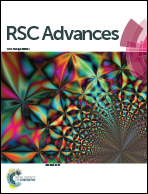Shape and stoichiometry control of bismuth selenide nanocrystals in colloidal synthesis†
Abstract
Three kinds of Bi–Se nanocrystals (Bi2Se3, Bi8Se9 and Bi1.007Se0.993) have been synthesized via a hot-injection approach. The colloid morphology, from hexagonal to octahedron, strongly depends on the injection temperature. The growth mechanism of Bi–Se nanocrystals is revealed here. A higher temperature could cause the reduction reaction from Bi3+ to Bi, and accelerate the reaction speed of Bi–Se, thus causing a difference of monomer concentration in bulk solution, which impacts the shapes of bismuth selenide nanocrystals as well as the composition. The three Bi–Se nanocrystals also show different optical and photoelectrocatalyst performance.



 Please wait while we load your content...
Please wait while we load your content...